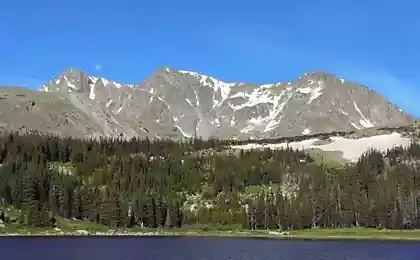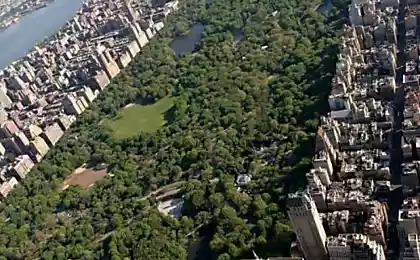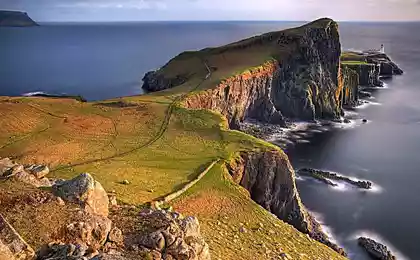451
National Park, Port Campbell, Australia
National Park Port Campbell – a protected national Park in Victoria, Australia, located 190 km South-West of Melbourne. Along its coastline there are numerous bizarre rock formations, gorges, arches and grottoes. As part of the shipwreck Coast, the Park preserves on its territory the famous tourist attraction – the limestone formation of the Twelve apostles, the London arch, the Grotto rock, Rattling the cave and no less beautiful gorge Loch-ARD.
Natural monument of the Twelve apostles is a group standing nearby limestone cliffs, nestled in the seaside National Park, Port Campbell in the arms of the raging sea. They lie on the path of the great ocean road stretches for 243 km along the scenic coastline of the Indian ocean. According to geologists the age of these rock formations can range from 10 to 20 million years. To date, the group had only 8 rocks, from a height up to 45 meters. The twelve apostles is one of the most popular and visited attractions in Victoria and throughout Australia, which is annually visited by about two million tourists.
Another popular tourist attraction of the Australian national Park, London arch is a natural arch on the coast of Victoria, formed as a result of a long erosion process. Her age – approximately 20 million years. Up to a point limestone formation was connected with the shore by a double arch. In January 1990, located closer to the shoreline collapsed span, concluding in the embrace of the water element two tourists, until they were rescued by helicopter. Before the collapse of the arch was known as London bridge because of the similarity with its British namesake.
Rock Grotto in the Park Port Campbell — a geological formation that has arisen as a result of constant exposure to ocean waves on a limestone formation.
Rattling cave is a place which received its name because of breaking into the gorge water, which, faced with stones, creates impressive sound effects.
Among local attractions also belongs to gorge the Loch ARD, which was named in honor of the ship, in June 1878 the wreck in this place. Cut local rocks tells multimillion the history of the planet, and the beach, nestled inside the gorge, offers excellent conditions for recreation.
National Park Port Campbell (about 700 hectares) was established in order to protect the local limestone formations in 1964. In 1981, its area was expanded to 1,750 acres.
All rocks of the area consist of limestone, which originated over 26 million years ago when the area was submerged under the water. Millions of tiny skeletons of dead marine animals accumulated on the sea bottom, causing the top of the clay layer gradually formed a layer of limestone at 260 feet. During the last glaciation, which occurred about 20 thousand years ago, sea levels dropped significantly, and grew up at the bottom of the rocks were on the surface. Fragile cliffs immediately began to be exposed to wind, rain and waves, causing every 20-30 years for many centuries, pieces of rock broke away and fell into the ocean. The coastline in some places retreated uniformly, leaving no signs of previous forms, but other, softer areas, succumbed to the destruction of earlier that led to the emergence of arches and pillars which today is so popular among fans of natural attractions.
The national Park is regularly exposed to harsh weather conditions from the southern ocean, which significantly complicates the conditions for the growth of plants. However, his land still give life to some species of flora – here you can meet representatives of the family Ericaceae, spinach, chamomile, daisies and orchids. Also in a protected area such trees as dogwood, Casuarina, eucalyptus and tea tree.
Fauna in the Park is mainly ornithological, and includes representatives of the family madisonivy, magmahost, painted malunov, peregrine falcons, pelicans, cormorants, ducks, herons, black swans, penguins, gannets, common petrels and wandering Albatross. Amphibians in the protected area is small Bandicoot, a small marsupial mouse and the echidna. In winter, by the shores of Victoria on the way from Antarctica to the Great Australian Bight, where spawning, floating giant South whales. Some of them are briefly linger off the coast for breeding, and all the rest, reaching 15 meters in length, going further along the coast, without fear of overcoming the raging waves and sharp rocks.
In an Australian National Park, Port Campbell has all the ingredients of the picturesque landscape – stunning views to the sea, amazing rock formations themselves unusual shapes and colorful the world of flora and fauna. All this makes it a must place to visit while traveling around Australia.
Source: udivitelno.com
Natural monument of the Twelve apostles is a group standing nearby limestone cliffs, nestled in the seaside National Park, Port Campbell in the arms of the raging sea. They lie on the path of the great ocean road stretches for 243 km along the scenic coastline of the Indian ocean. According to geologists the age of these rock formations can range from 10 to 20 million years. To date, the group had only 8 rocks, from a height up to 45 meters. The twelve apostles is one of the most popular and visited attractions in Victoria and throughout Australia, which is annually visited by about two million tourists.
Another popular tourist attraction of the Australian national Park, London arch is a natural arch on the coast of Victoria, formed as a result of a long erosion process. Her age – approximately 20 million years. Up to a point limestone formation was connected with the shore by a double arch. In January 1990, located closer to the shoreline collapsed span, concluding in the embrace of the water element two tourists, until they were rescued by helicopter. Before the collapse of the arch was known as London bridge because of the similarity with its British namesake.
Rock Grotto in the Park Port Campbell — a geological formation that has arisen as a result of constant exposure to ocean waves on a limestone formation.
Rattling cave is a place which received its name because of breaking into the gorge water, which, faced with stones, creates impressive sound effects.
Among local attractions also belongs to gorge the Loch ARD, which was named in honor of the ship, in June 1878 the wreck in this place. Cut local rocks tells multimillion the history of the planet, and the beach, nestled inside the gorge, offers excellent conditions for recreation.
National Park Port Campbell (about 700 hectares) was established in order to protect the local limestone formations in 1964. In 1981, its area was expanded to 1,750 acres.
All rocks of the area consist of limestone, which originated over 26 million years ago when the area was submerged under the water. Millions of tiny skeletons of dead marine animals accumulated on the sea bottom, causing the top of the clay layer gradually formed a layer of limestone at 260 feet. During the last glaciation, which occurred about 20 thousand years ago, sea levels dropped significantly, and grew up at the bottom of the rocks were on the surface. Fragile cliffs immediately began to be exposed to wind, rain and waves, causing every 20-30 years for many centuries, pieces of rock broke away and fell into the ocean. The coastline in some places retreated uniformly, leaving no signs of previous forms, but other, softer areas, succumbed to the destruction of earlier that led to the emergence of arches and pillars which today is so popular among fans of natural attractions.
The national Park is regularly exposed to harsh weather conditions from the southern ocean, which significantly complicates the conditions for the growth of plants. However, his land still give life to some species of flora – here you can meet representatives of the family Ericaceae, spinach, chamomile, daisies and orchids. Also in a protected area such trees as dogwood, Casuarina, eucalyptus and tea tree.
Fauna in the Park is mainly ornithological, and includes representatives of the family madisonivy, magmahost, painted malunov, peregrine falcons, pelicans, cormorants, ducks, herons, black swans, penguins, gannets, common petrels and wandering Albatross. Amphibians in the protected area is small Bandicoot, a small marsupial mouse and the echidna. In winter, by the shores of Victoria on the way from Antarctica to the Great Australian Bight, where spawning, floating giant South whales. Some of them are briefly linger off the coast for breeding, and all the rest, reaching 15 meters in length, going further along the coast, without fear of overcoming the raging waves and sharp rocks.
In an Australian National Park, Port Campbell has all the ingredients of the picturesque landscape – stunning views to the sea, amazing rock formations themselves unusual shapes and colorful the world of flora and fauna. All this makes it a must place to visit while traveling around Australia.
Source: udivitelno.com























